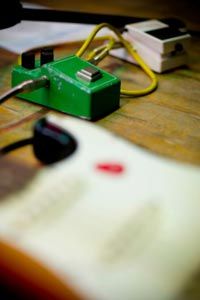Make It Loud: Boosting, Compressing or Distorting a Signal
Ask most guitarists which pedal they would keep if they landed on a desert island with only a guitar, an amp and one effect, and it would probably be some sort of booster pedal. In the journey toward the weirdest guitar sounds imaginable, pedals that affect a guitar's volume are the first steps along the path.
Compression, booster and preamp pedals affect a guitar's signal in a clean, non-distorted way. Preamps or booster pedals raise the overall level of a signal; electric players often use these to egg their tube amps info overdrive. Compression pedals, on the other hand, narrow a tone's dynamic range by limiting the attack on a note and amplifying its decay. Put your compressor or preamp at the beginning of your effects chain to send hot, clean, level signals to the rest of your stomp boxes. Slap a noise gate pedal at the end of your chain to silence hiss and unwanted noise from other pedals. (Be careful with noise gates, however. They may clip off your guitar's sustain, creating an unnatural stutter.)
Advertisement
Though clean-sounding booster pedals are fine, what many players want most is a way to add a bunch of distortion to their sound. Here are three different ways to dirty up your tone:
- Overdrive. Original overdrive occurred when players first cranked their tube amplifiers up to 10. Overdrive is literally the sound of vacuum tubes pushed to their limits. Overdrive pedals either boost a guitar's gain, sending the player's (tube) amplifier into an overdriven state, or they try to replicate the sound of an overdriven tube amp.
- Distortion. Distortion pedals overdrive the sound of overdrive by boosting levels and altering waveform.
- Fuzz. Ike Turner and the Rhythm Kings guitarist Willie Kizert captured one of earliest recorded fuzz tones when he tracked the song "Rocket 88" through a Fender Bassman amp that had blown a tube after being dropped on the street in the rain [source: Hunter]. Literally the sound of a busted amplifier, fuzz distorts distortion itself to create the kind of buzzy, hum-tone heard in songs like the Rolling Stones' "(I Can't Get No) Satisfaction."
Now that you've learned how to muddy up your sound, let's take a look at ways to make it weirder. Next, we explore the wide world of modulation effects.
